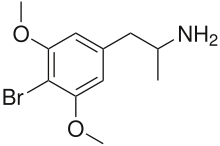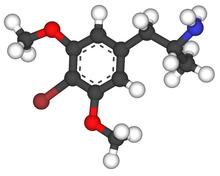 | |
 | |
| Names | |
|---|---|
| Preferred IUPAC name 1-(4-Bromo-3,5-dimethoxyphenyl)propan-2-amine | |
| Other names 4-Bromo-3,5-dimethoxyamphetamine 2-(4-Bromo-3,5-dimethoxy-phenyl)-1-methyl-ethylamine 2-(4-Bromo-3,5-dimethoxyphenyl)ethan-1-methyl-amine | |
| Identifiers | |
3D model (JSmol) | |
| ChEMBL | |
| ChemSpider | |
PubChem CID | |
CompTox Dashboard (EPA) | |
| |
SMILES
| |
| Properties | |
| C11H17BrNO2 | |
| Molar mass | 275.166 g·mol−1 |
Except where otherwise noted, data are given for materials in their standard state (at 25 °C [77 °F], 100 kPa). | |
4-Bromo-3,5-dimethoxyamphetamine is a lesser-known psychedelic drug and a substituted amphetamine. It was first synthesized by Alexander Shulgin. In his book PiHKAL, the dosage range is listed as 4–10 mg and the duration is listed as 8–12 hours.[1] It produces analgesia, numbness, and reduction of physical feeling. Very little data exists about its pharmacological properties, metabolism, and toxicity.
See also
References